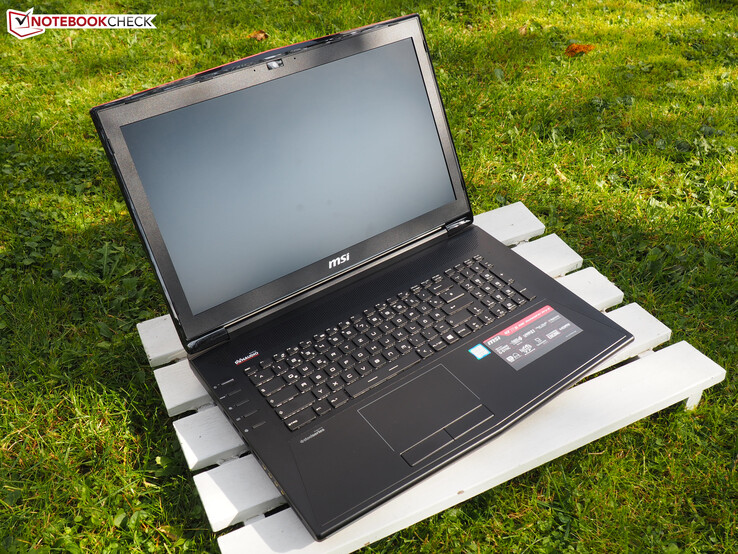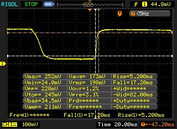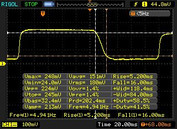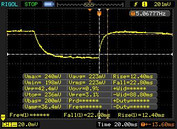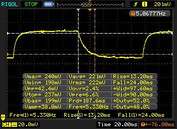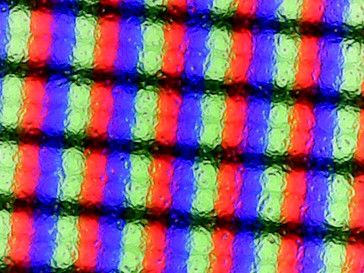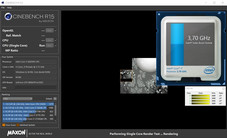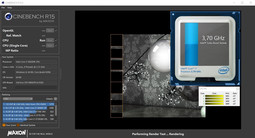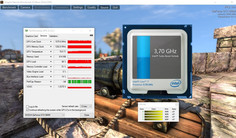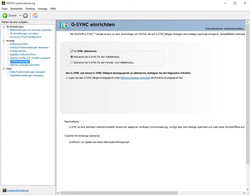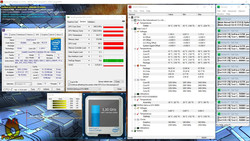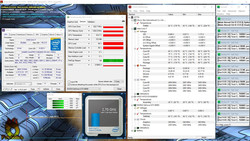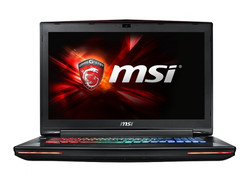MSI GT72S 6QE Dominator Pro G Notebook Review

For the original German review, see here.
Unlike the predecessors that were furnished with a CPU from the Haswell or Broadwell platform, MSI now relies on the brand new Skylake architecture in its latest GT72. Although it did not exactly stand out with higher performance in prior tests, its considerably lower power consumption was striking (e.g. in this review).
We opted for the 2700 Euro (~$3075) top model GT72S-6QEG16SR421BW for this report. In contrast to most family members, it does not sport a Core i7-6700HQ (2.6-3.5 GHz, 6 MB L3 cache), but a Core Core i7-6820HK (2.7-3.6 GHz, 8 MB L3 cache instead. A 16 GB working memory (2 of 4 slots filled) and a 1000 GB, 7200 rpm HDD accompany that. The 64-bit version of Windows 10 is, however, installed on a 256 GB solid-state drive. The highlight: Thanks to NVMe technology, the M.2 model scores much better than conventional SATA III SSDs.
Another highlight is the matte, Full HD screen that can boast very high viewing angle stability. Buyers on a tighter budget and limited to spend at most 2000 Euros (~$2278) on a laptop will find a match in the GT72-6QD. The lower priced model features a GeForce GTX 970M rather than GTX 980M.
Innovations
The GT72S-6QE is nearly identical to the GT72-2QE that we tested not quite four months ago. With the exception of the slightly reworked interfaces, both laptops look similar and thus we will not reassess the chassis, connectivity, input devices or speakers. Major modifications are only found in technology and features:
- The GT72 now supports Nvidia's G-Sync, which prevents screen tearing and ensures a smoother image
- A CM236 chipset is now the motherboard (previously HM87)
- The GDDR5 video memory of the GeForce GTX 980M has twice the capacity with 8 GB rather than 4 GB
- The Core i7-6820HK Skylake processor has a free multiplier that facilitates overclocking
- The CPU's clock is permanently boosted to 3.7 GHz in Sport Mode (Fn + F7)
- Two of the four M.2 slots support PCIe respectively NVMe for particularly swift solid-state drives
- A DDR4 rather than DDR3 RAM working memory is installed
- MSI supplements the GT72 with a high-quality audio DAC converter (ESS SABRE Hi-Fi) that is to improve the sound quality of headsets
Interface fanatics will be pleased about the "SuperPort". The USB 3.1 port is also compatible with Thunderbolt and DisplayPort (two 4K monitors via Daisy Chain).
The LP173WF4-SPF1 screen from LG Philips again takes care of image output. Some of the rates have improved compared with the last test, which is likely due to production variances.
| |||||||||||||||||||||||||
Brightness Distribution: 90 %
Center on Battery: 322 cd/m²
Contrast: 1073:1 (Black: 0.3 cd/m²)
ΔE ColorChecker Calman: 3.78 | ∀{0.5-29.43 Ø4.78}
ΔE Greyscale Calman: 2.43 | ∀{0.09-98 Ø5}
85% sRGB (Argyll 1.6.3 3D)
56% AdobeRGB 1998 (Argyll 1.6.3 3D)
62.3% AdobeRGB 1998 (Argyll 3D)
85.2% sRGB (Argyll 3D)
66.6% Display P3 (Argyll 3D)
Gamma: 2.54
CCT: 6706 K
The average brightness of over 300 cd/m² and a contrast higher than 1000:1 places the GT72S in the first league. The black level is also compelling: 0.3 cd/m² are good for an IPS panel. We are not as satisfied with the illumination. Although the screen achieves 90% on paper, minor screen bleeding is noticed at the edges of the review sample. However, that is often the case in many laptops and will not annoy every user.
| MSI GT72S-6QEG16SR421BW LG Philips LP173WF4-SPF1 (LGD0469) | MSI GT72-2QE16SR21BW LP173WF4-SPF1 (LGD0469) | Asus G751JY LG Philips LP173WF4-SPD1 (LGD046C) | Alienware 17 R2 LG Philips LGD0459 / 173WF4 (Dell P/N: CV69H) | Schenker XMG U706 LG LP173WF4-SPD1 | |
|---|---|---|---|---|---|
| Display | 2% | -2% | -1% | -1% | |
| Display P3 Coverage (%) | 66.6 | 68.1 2% | 65.9 -1% | 66.6 0% | 66.6 0% |
| sRGB Coverage (%) | 85.2 | 86.7 2% | 83.1 -2% | 84.3 -1% | 84.7 -1% |
| AdobeRGB 1998 Coverage (%) | 62.3 | 63.4 2% | 60.8 -2% | 61.6 -1% | 61.9 -1% |
| Screen | -27% | -9% | -9% | -7% | |
| Brightness middle (cd/m²) | 322 | 285 -11% | 329 2% | 331 3% | 298 -7% |
| Brightness (cd/m²) | 315 | 278 -12% | 320 2% | 307 -3% | 287 -9% |
| Brightness Distribution (%) | 90 | 87 -3% | 92 2% | 84 -7% | 91 1% |
| Black Level * (cd/m²) | 0.3 | 0.45 -50% | 0.34 -13% | 0.3 -0% | 0.305 -2% |
| Contrast (:1) | 1073 | 633 -41% | 968 -10% | 1103 3% | 977 -9% |
| Colorchecker dE 2000 * | 3.78 | 5.1 -35% | 4.13 -9% | 4.88 -29% | 4.16 -10% |
| Colorchecker dE 2000 max. * | 7.75 | 8.01 -3% | |||
| Greyscale dE 2000 * | 2.43 | 5.23 -115% | 3.72 -53% | 3.63 -49% | 3.13 -29% |
| Gamma | 2.54 87% | 2.32 95% | 2.36 93% | 2.17 101% | 2.26 97% |
| CCT | 6706 97% | 7565 86% | 6352 102% | 6325 103% | 6213 105% |
| Color Space (Percent of AdobeRGB 1998) (%) | 56 | 57 2% | 55 -2% | 55 -2% | 55.5 -1% |
| Color Space (Percent of sRGB) (%) | 85 | 87 2% | 83 -2% | 84.2 -1% | 84.5 -1% |
| Total Average (Program / Settings) | -13% /
-20% | -6% /
-7% | -5% /
-7% | -4% /
-6% |
* ... smaller is better
Plus points are especially awarded for the True Color software that allows setting the screen to different scenarios, such as Designer, Office or Movie. The GT72S performed the color assessments using the default sRGB profile. The screenshots below illustrate that the balance is quite good, and that post calibration barely leads to improvements.
Speaking of screenshots: We recently expanded the test with a number of new measurements. The subpixel structure and response time for switching from black to white or gray to gray are among that. We also test whether a pulse width modulation occurs (some users perceive PWM as flickering), which is fortunately not the case in the GT72S. The screen does not have to accept criticism in terms of color space coverage, either. 85% sRGB and 56% AdobeRGB are decent.
Only high-end components are found under the hood. 16 GB of RAM and a total of 1.25 terabyte hard drive capacity mark the luxury claim just as much as a quad-core processor. MSI installs Nvidia's currently strongest graphics chip, although the GeForce GTX 980M will soon find a rival in the GTX 980.
Processor
While the CPUs from the Haswell platform were still built in the 22 nm process, the architectures of both the Broadwell and Skylake are based on 14 nm. To improve the processor's performance, MSI uses the Core i7-6820HK that has an additional 2 MB of L3 cache, a somewhat lower TDP (45 vs. 47 watts) and a marginally better clock rate (2.7-3.6 vs. 2.7-3.5 GHz) than the Core i7-5700HQ.
However, the Core i7-6820HK runs at 3.7 GHz when the Sport Mode is active, as mentioned above. That also explains a major part of the difference. Great: The 3.7 GHz were maintained stably in the test with the Cinebench R15 and Unigine Heaven 4.0 benchmarks. The clock rate only dropped to 3.3 or 2.7 GHz after a while in the stress test, based on relatively unrealistic conditions. Throttling, i.e. speeds below the base rate, were never observed.
Thanks to the high clock, the Core i7-6820HK outruns the popular laptop Core i7-4720HQ from the Haswell generation by over 10% in the single-CPU tests and almost 20% in the multi-CPU tests. The Core i7-5700HQ in the GT72-2QE is also defeated, although the difference is not as great. A desktop processor, such as Schenker installs in its XMG U706, would be needed to retrieve even more power (the Core i7-6700K calculates almost 10% faster).
System Performance
Unsurprisingly, the system performance is on a very high level. The total score in PCMark 7 is in line with the 17-inch rivals. MSI's GT72S, like Asus' G751JY, Alienware's 17 R2 and Schenker's XMG U706, all achieve over 6000 points.
| PCMark 7 Score | 6439 points | |
Help | ||
Storage Device
The cutting edge NVMe SSD is one of the biggest unique selling points. The 256 GB model, THNSN5256GPU7, delivers an impressive presentation in CrystalDiskMark. Only a RAID array composed of multiple SSDs - if at all - outperform 1602 MB/s in sequential read and 1062 MB/s in sequential write. Even the 512 GB model of Samsung's SM951 (PCIe x4) has a hard time competing against the NVMe drive. Note: The AS SSD benchmark still currently records much too low write rates.
A conventional hard drive rounds off the package. The combination of high storage capacity (1000 GB) and swift speed (7200 rpm) ensure good performance. Only few HDDs achieve sequential rates of over 130 MB/s. Respect: According to MSI, up to five storage devices are possible (4x M.2 & 1x 2.5 inches).
Graphics Card
Despite the exorbitant price, we would say that the GeForce GTX 980M is the first choice for demanding gamers. Nvidia's top model is strong enough to render most games smoothly even using maximum details and multiple anti-aliasing. As long as the user does not overdo it with the settings, the performance is even sufficient for 4K, i.e. 3840x2160 pixels. Only hardware-guzzlers like "Batman: Arkham Knight" scream for a desktop GPU.
| 3DMark 11 Performance | 11488 points | |
| 3DMark Ice Storm Standard Score | 148970 points | |
| 3DMark Cloud Gate Standard Score | 25411 points | |
| 3DMark Fire Strike Score | 8414 points | |
| 3DMark Time Spy Score | 2949 points | |
Help | ||
The performance, unsurprisingly, is in line with other 980M laptops in the synthetic graphic benchmarks. With 8414 points in the Fire Strike test of 3DMark 2013, the GT72S is situated between Alienware's 17 R2 and Asus' G751JY that achieve 8185 respectively 8559 points. Smaller deviations are normal here since the graphics driver and CPU clock are not identical.
| 3DMark | |
| 3840x2160 Fire Strike Ultra Score (sort by value) | |
| MSI GT72S-6QEG16SR421BW | |
| 1920x1080 Fire Strike Score (sort by value) | |
| MSI GT72S-6QEG16SR421BW | |
| MSI GT72-2QE16SR21BW | |
| Asus G751JY | |
| Alienware 17 R2 | |
| Schenker XMG U706 | |
| 3DMark 11 - 1280x720 Performance (sort by value) | |
| MSI GT72S-6QEG16SR421BW | |
| MSI GT72-2QE16SR21BW | |
| Asus G751JY | |
| Alienware 17 R2 | |
| Schenker XMG U706 | |
Gaming Performance
The GeForce GTX 980M looks outstanding when only using the GT72S's native resolution. The Maxwell chip easily copes with 1920x1080 pixels, as our chart illustrates. All eight games we tested ran at over 40 fps in the Ultra setting. That was not always the case with the GeForce GTX 970M. However, buyers on a tighter budget should nevertheless opt for the cheaper model. The surcharge is hardly worthwhile depending on the game.
The CPU's influence is very limited. A certain advantage of the quad-core models that are not additionally overclocked is first noticed in low settings.
| low | med. | high | ultra | 4K | |
|---|---|---|---|---|---|
| World of Warcraft (2005) | 89 | ||||
| Diablo III (2012) | 184 | ||||
| Counter-Strike: GO (2012) | 230 | ||||
| Battlefield 4 (2013) | 199.6 | 198.6 | 157.4 | 70.1 | 36.9 |
| X-Plane 10.25 (2013) | 120 | 58.7 | 32.6 | 27.3 | |
| Watch Dogs (2014) | 116 | 104.9 | 62.4 | 47.4 | |
| Sims 4 (2014) | 191.9 | 151.6 | 121.8 | 111.2 | |
| Far Cry 4 (2014) | 134.5 | 127 | 76 | 61.1 | |
| Batman: Arkham Knight (2015) | 133 | 119 | 75 | 51 | 23 |
| Metal Gear Solid V (2015) | 59.9 | 59.9 | 59.9 | 59.9 | 36 |
| Mad Max (2015) | 204.5 | 103.2 | 96.4 | 33.7 | |
| FIFA 16 (2015) | 334.3 | 274.9 | 197.6 | 88.6 |
Emissions
Note: All following assessments were performed in Nvidia Mode. Theoretically, it would be possible to activate the processor's graphics chip by pressing the GPU hot key. That would result in lower power consumption and increase the battery life accordingly. However, barely any gamer will use this feature excessively since the laptop has to be rebooted for that. That is similarly true for the Cooler Boost button that speeds up the fan in favor of the temperatures, and which we believe involves more disadvantages than advantages (the system gets too loud).
System Noise
Good news in terms of system noise: Although the Broadwell edition of the GT72 already belonged to the quietest gamers on the market, MSI has managed to reduce the noise development even more. In contrast to 39.3 dB(A), the GT72S now only reaches an average of 35 dB(A) in 3DMark 06, and closes in on the previous silent runner Asus G751JY (34.6 dB(A)) and is on an audibly lower level than Schenker's XMG U706 (42.1 dB(A)) or Alienware's 17 R2 (43.4 dB(A)).
However, MSI's laptop is extremely tall with a height of 4.8 centimeters (~1.9 in), which allows installing a stronger cooling system. 3.8 kilograms (~8.4 lb) also speak for more stationary use. But back to topic: The GT72S is only really loud when under full load. 46 dB(A) is very similar to the maximum rate of the GT72-2QE.
The 17-incher is agreeably quiet in idle mode. Although both casing fans are always active, a subtle noise of 30 - 31 dB(A) is not distracting. We only criticize the temporary speed increases. The fans speed up to 50 dB(A) for a moment right after booting and changing the Shift Mode, which gets very annoying after a while. MSI should certainly take care of this issue.
Noise level
| Idle |
| 30.6 / 31 / 50.4 dB(A) |
| DVD |
| 33.8 / dB(A) |
| Load |
| 35 / 46 dB(A) |
 | ||
30 dB silent 40 dB(A) audible 50 dB(A) loud |
||
min: | ||
| MSI GT72S-6QEG16SR421BW GeForce GTX 980M, 6820HK | MSI GT72-2QE16SR21BW GeForce GTX 980M, 5700HQ | Asus G751JY GeForce GTX 980M, 4720HQ | Alienware 17 R2 GeForce GTX 980M, 4980HQ | Schenker XMG U706 GeForce GTX 980M, 6700K | |
|---|---|---|---|---|---|
| Noise | 1% | 7% | 0% | 6% | |
| Idle Minimum * (dB) | 30.6 | 33.2 -8% | 31.2 -2% | 29.4 4% | 29 5% |
| Idle Average * (dB) | 31 | 33.6 -8% | 33 -6% | 30.8 1% | 30.8 1% |
| Idle Maximum * (dB) | 50.4 | 34.4 32% | 34.2 32% | 35 31% | 30.8 39% |
| Load Average * (dB) | 35 | 39.3 -12% | 34.6 1% | 43.4 -24% | 42.1 -20% |
| Load Maximum * (dB) | 46 | 46.4 -1% | 41.4 10% | 51.6 -12% | 43.5 5% |
* ... smaller is better
Temperature
We cannot confirm that Intel's Skylake architecture generally produces less waste heat and consequently noise than Broadwell or Haswell. MSI has modified fan management so that the components may reach a somewhat higher temperature.
Both the upper side and the underside of the base unit achieved roughly the same temperatures as the predecessor in the stress test and while idling - despite a cooler environment (22 vs. 25 °C / 71.6 vs. 77 °F). However, the temperatures are not above average when all results are totaled. Subjectively, the casing never feels unpleasant when placed on a table. We could only measure 31 °C (87.8 °F) on the wrist rest even during full load.
The situation is not quite as carefree inside the casing. The processor reached approximately 90 °C (194 °F) (~80 °C/176 °F with disabled Turbo) after our one-hour stress test using the tools FurMark and Prime95. According to GPU-z, the graphics chip reached a maximum of 85 °C (185 °F), but with minor throttling. However, neither critical temperatures nor throttling developed in gaming operation.
(-) The maximum temperature on the upper side is 45.2 °C / 113 F, compared to the average of 40.4 °C / 105 F, ranging from 21.2 to 68.8 °C for the class Gaming.
(-) The bottom heats up to a maximum of 56.9 °C / 134 F, compared to the average of 43.3 °C / 110 F
(+) In idle usage, the average temperature for the upper side is 29.3 °C / 85 F, compared to the device average of 33.9 °C / 93 F.
(+) The palmrests and touchpad are cooler than skin temperature with a maximum of 31.1 °C / 88 F and are therefore cool to the touch.
(-) The average temperature of the palmrest area of similar devices was 28.8 °C / 83.8 F (-2.3 °C / -4.2 F).
| MSI GT72S-6QEG16SR421BW GeForce GTX 980M, 6820HK | MSI GT72-2QE16SR21BW GeForce GTX 980M, 5700HQ | Asus G751JY GeForce GTX 980M, 4720HQ | Alienware 17 R2 GeForce GTX 980M, 4980HQ | Schenker XMG U706 GeForce GTX 980M, 6700K | |
|---|---|---|---|---|---|
| Heat | -1% | 2% | 0% | -5% | |
| Maximum Upper Side * (°C) | 45.2 | 45 -0% | 46.8 -4% | 50.8 -12% | 45.6 -1% |
| Maximum Bottom * (°C) | 56.9 | 54.9 4% | 51.9 9% | 48.7 14% | 52.4 8% |
| Idle Upper Side * (°C) | 30.7 | 32.4 -6% | 30.7 -0% | 30.9 -1% | 34.9 -14% |
| Idle Bottom * (°C) | 31.8 | 32.4 -2% | 30.5 4% | 31.7 -0% | 36.3 -14% |
* ... smaller is better
Energy Management
Power Consumption
At least the idle power consumption is lower than in the last review sample. 21.3 - 32.9 rather than 28.0 - 35.7 watts ensure somewhat longer runtimes. The main reason is likely the new Skylake CPU that is more frugal in basic applications. On the other hand, the new model consumes more power under load. Our instrument recorded an average of 110.2 rather than 101 watts in the first scene of 3DMark 06. The maximum consumption was also higher (230.8 vs. 212.2 watts).
| Off / Standby | |
| Idle | |
| Load |
|
Key:
min: | |
| MSI GT72S-6QEG16SR421BW GeForce GTX 980M, 6820HK | MSI GT72-2QE16SR21BW GeForce GTX 980M, 5700HQ | Asus G751JY GeForce GTX 980M, 4720HQ | Alienware 17 R2 GeForce GTX 980M, 4980HQ | Schenker XMG U706 GeForce GTX 980M, 6700K | |
|---|---|---|---|---|---|
| Power Consumption | -10% | 0% | 26% | -6% | |
| Idle Minimum * (Watt) | 21.3 | 28 -31% | 24.2 -14% | 8.9 58% | 22 -3% |
| Idle Average * (Watt) | 26.3 | 33.3 -27% | 29.4 -12% | 16 39% | 28.9 -10% |
| Idle Maximum * (Watt) | 32.9 | 35.7 -9% | 33.9 -3% | 26.6 19% | 29.8 9% |
| Load Average * (Watt) | 110.2 | 101 8% | 93.4 15% | 124 -13% | 126.8 -15% |
| Load Maximum * (Watt) | 230.8 | 212.2 8% | 196.8 15% | 165.8 28% | 261.6 -13% |
* ... smaller is better
Battery Runtime
The GT72S runs for around 1 - 4.5 hours without its power adapter when the GeForce GTX 980M is enabled. Gaming laptops that do not feature graphics switching (e.g. Schenker's XMG U706) settle to similar rates. Laptops with Nvidia's Optimus technology (automatic graphics switching) usually last longer. Alienware's 17 R2 was depleted only after 12 hours in the idle test. When preferred - as said - Intel's HD Graphics 530 chip can be activated, which should massively increase the runtime.
| MSI GT72S-6QEG16SR421BW GeForce GTX 980M, 6820HK | MSI GT72-2QE16SR21BW GeForce GTX 980M, 5700HQ | Asus G751JY GeForce GTX 980M, 4720HQ | Alienware 17 R2 GeForce GTX 980M, 4980HQ | Schenker XMG U706 GeForce GTX 980M, 6700K | |
|---|---|---|---|---|---|
| Battery runtime | 2% | -6% | 110% | -4% | |
| Reader / Idle (h) | 4.4 | 3.8 -14% | 3.5 -20% | 12.2 177% | 4.1 -7% |
| Load (h) | 1.2 | 1.4 17% | 1.3 8% | 1.7 42% | 1.2 0% |
Pros
Cons
Verdict
MSI has tuned its successful 17-inch GT72 flagship in the right places. More CPU power, twice the video memory, DDR4 RAM, NVMe SSD, and Nvidia's G-Sync technology are definitely welcome. Although the chassis is still relatively heavy and big, the gaming platform is perfectly suitable as a full-fledged desktop replacement.
No matter whether connectivity, screen or input devices: MSI delivers a good to very good job in almost every aspect. After getting used to the unusual keyboard layout and the rubberized wrist rest, nothing stands in the way of extensive gaming sessions. Temperature and noise development are mostly moderate, and the multitude of interfaces and upgrade options as well as the superb sound quality also have to be lauded.
MSI could improve the cover's stiffness, the Wi-Fi range and battery's accessibility, though.
MSI GT72S-6QEG16SR421BW
- 01/20/2016 v5 (old)
Florian Glaser










